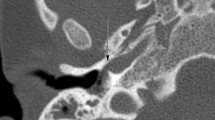Abstract
The temporal bone is formed by the fusion of five distinct osseous portions, including the tympanic, squamous, mastoid, petrous, and the styloid process. It houses the hearing and vestibular organs, numerous nerves and vessels, and fits into the base of the skull between the sphenoid and the occipital bones, and separates the middle cranial fossa from the posterior cranial fossa.
Access provided by Autonomous University of Puebla. Download chapter PDF
Similar content being viewed by others
1.1 Temporal Bone Preparation and High Resolution CT Scan
1.1.1 Location of the Temporal Bone
The temporal bone is formed by the fusion of five distinct osseous portions, including the tympanic, squamous, mastoid, petrous, and the styloid process. It houses the hearing and vestibular organs, numerous nerves and vessels, and fits into the base of the skull between the sphenoid and the occipital bones, and separates the middle cranial fossa from the posterior cranial fossa.
1.1.2 Temporal Bone Preparation
Twelve temporal bones from six corpses were provided by the Beijing Institute of Otolaryngology. In order to reduce the liquid artifact when micro-CT scanning, the corpses were ventilated for some time to let the fixation liquid (the condition of the corpse can be examined by HRCT scan) discharge via the eustachian tube. After taken out from the corpse, only the primary part of the temporal bone including the external auditory canal, middle ear, inner ear, and internal auditory canal was remained so that the block of the temporal bone could be accommodated by the micro-CT scanner. The block is dissected as following:
-
Superiorly: arcuate eminence of the anterior semicircular canal.
-
Inferiorly: stylomastoid foramen.
-
Laterally: bony opening of external auditory canal.
-
Medially: petrous apex.
-
Anteriorly: posterior wall of temporomandibular articulation and the foramen lacerum
-
Posteriorly: sigmoid sinus.
The block of temporal bone is approximately 5 cm × 4 cm × 3 cm (Fig. 1.1).
1.1.3 High Resolution CT Scan
High resolution computed tomography (HRCT) examinations were performed on the above-mentioned corpses with 1 mm contiguous sections before dissection. The equipment utilized was a Philips Brilliance 64 CT scanner (Philips, the Netherlands). The imaging parameters were as follows: voltage 120 Kv, current 200 mA, matrix 512 × 512, reconstructing section thickness 1 mm. The images were reconstructed using a high resolution bone algorithm. A window width of 4000 Hounsfield Units (HU) and a window center of 700 HU were preferred for reading these high resolution images. The final resolution is 0.65 mm.
The protocol was approved by the Institutional Committee of the Beijing Institute of Otolaryngology.
1.2 The Principles and Conditions of Micro-CT Scan
The basic principle of the micro-CT scan is using the microfocus X-ray tube to scan and project the specimen (such as the small animals): the hard tissues and the related soft tissues on different planes with cone beam, the detector accepts the X-ray which transmits these planes, the X-ray is first converted to the visible light, then converted to electric signal by light-electric converter, this signal is converted to digital signal via Analog to Digital Converter later, the projections are captured along the long axis of the specimen and reconstructed using a software (Inveon Research Workstation).
The bilateral temporal bones were scanned, respectively, with the micro-CT scanner (Siemens, Inveon, Germany) (Fig. 1.2). The long axis of the temporal bone parallels to the scan backplane. Scan parameters were as follows: The X-ray source voltage was set to 80 kV and current to 500 μA, image acquisition time: 20 min, auto-reconstruction time: 30 min, the diameter of X-ray: 50 μm, radioactive source: 30.6 mm × 45.9 mm, exposure time: 2000 ms, detector pixel: 3072 × 2048, image:1024 × 1024 pixel, and the resultant resolution was 29.86 μm.
1.3 The Significance and Methods of Two-Dimensional and Three-Dimensional Reconstruction for Temporal Bone
Micro-CT scan can provide the basic knowledge for scientific study and preclinical research. Because of the excellent spatial resolution, micro-CT can also show the two-dimensional and three-dimensional microstructures of the temporal bone clearly, such as the stapes, incudostapedial articulation, the fundus of internal auditory canal, and so on.
The digital data from micro-CT scan is input the computer, the intrastructures of temporal bone are oriented by rotating the image at different directions over and over again, until a certain structure (such as the lateral semicircular canal) is shown on one plane just as shown on HRCT image, then the two-dimensional images on axial, coronal, and sagittal view are built, respectively, three-dimensional reconstruction is made via software-mimics (Materialise.Mimics.Innovation.Suite.Research.v17.0.x64_p30download.com) (Fig. 1.3), and the semi-transparency is made via 3-matic Research 11.0 (x64).
1.4 Preparation and Clinical Significance of Man-Made Tiny Lesion Models in Temporal Bone
The diagnosis of the tiny lesions in temporal bone has always bewildered the radiologist and the otologist for a long time because of the insufficient resolution of clinical CT. These diseases, such as the dislocation, fenestration, and fracture of the stapedial footplates, the dislocation of incudostapedial articulation, and the atresia of the vestibular window, were usually identified during the operation at present. In this atlas, we made several tiny lesion models in the temporal bone under the surgical microscope, such as the dislocation, perforation, and fracture of the stapedial footplates et al. (the details see the Chaps. 8 and 9), and observed if these man-made disease models could be shown clearly via micro-CT scanning.
Author information
Authors and Affiliations
Editor information
Editors and Affiliations
Rights and permissions
Copyright information
© 2021 The Author(s), under exclusive license to Springer Nature Singapore Pte Ltd.
About this chapter
Cite this chapter
Yu, Z., Zhang, L., Han, D. (2021). Principles and Conditions of Micro-CT Scan. In: Yu, Z., Zhang, L., Han, D. (eds) Micro-CT of Temporal Bone. Springer, Singapore. https://doi.org/10.1007/978-981-16-0807-0_1
Download citation
DOI: https://doi.org/10.1007/978-981-16-0807-0_1
Published:
Publisher Name: Springer, Singapore
Print ISBN: 978-981-16-0806-3
Online ISBN: 978-981-16-0807-0
eBook Packages: MedicineMedicine (R0)







